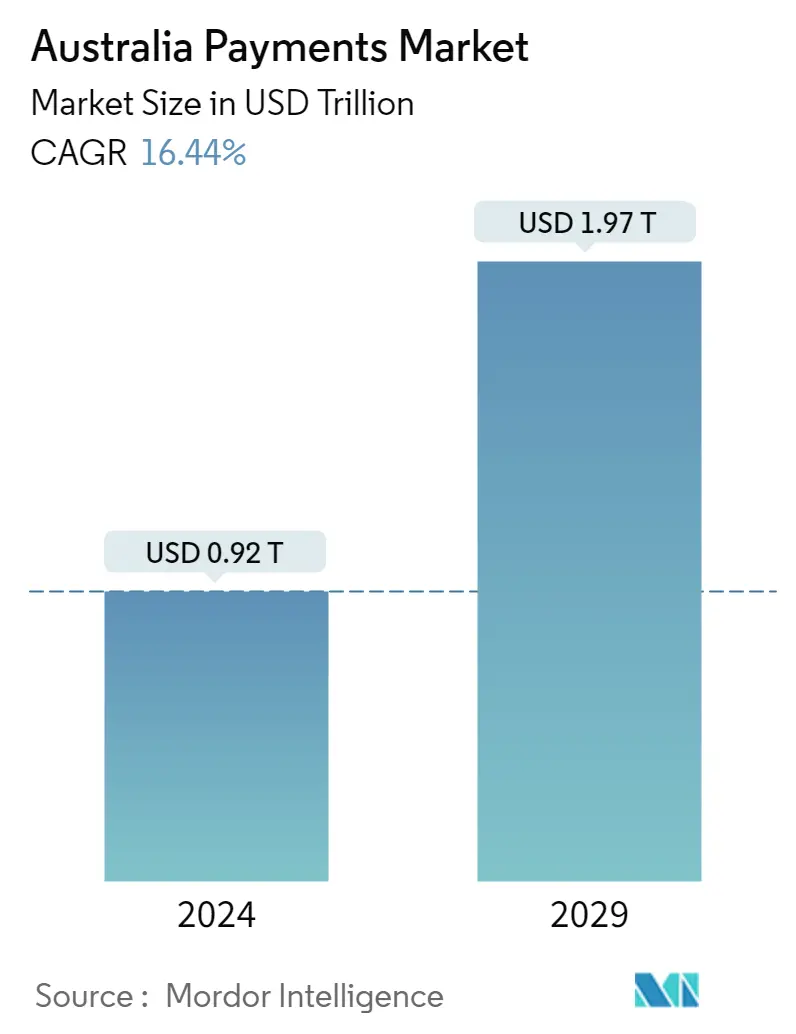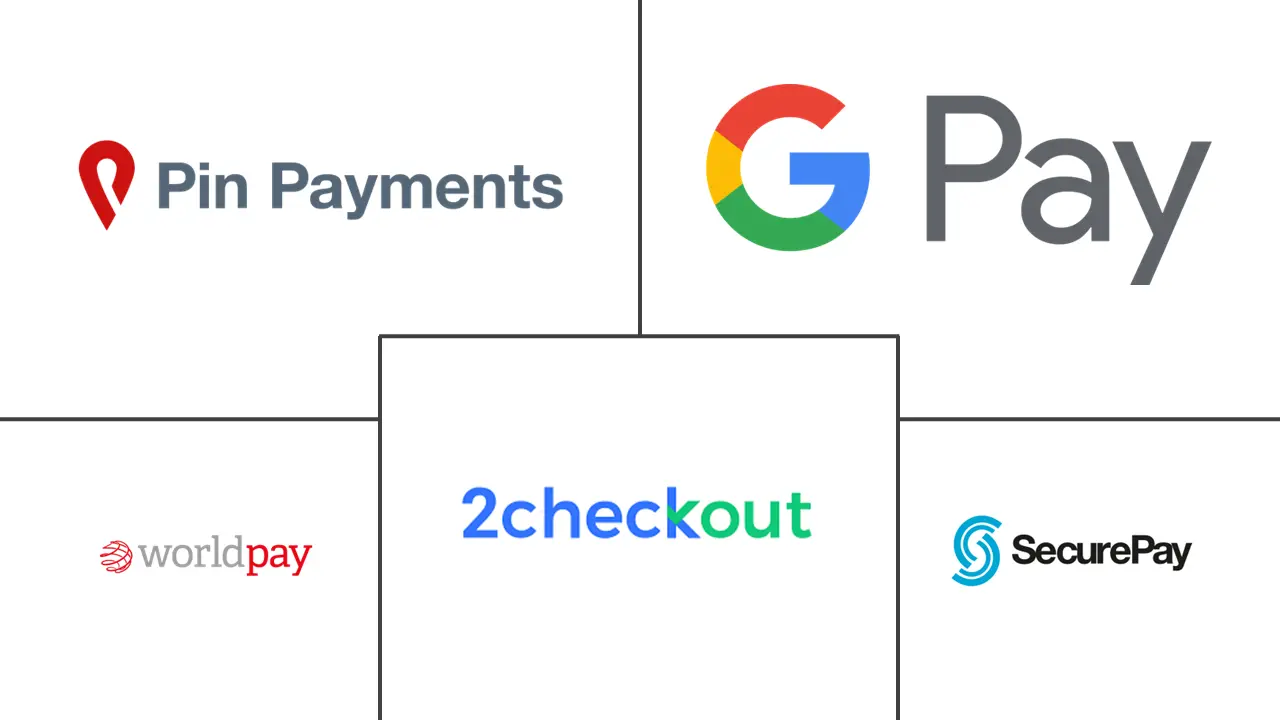Market Size of Australia Payments Industry

| Study Period | 2019 - 2029 |
| Base Year For Estimation | 2023 |
| Market Size (2024) | USD 0.92 Trillion |
| Market Size (2029) | USD 1.97 Trillion |
| CAGR (2024 - 2029) | 16.44 % |
| Market Concentration | Low |
Major Players
*Disclaimer: Major Players sorted in no particular order |
Australia Payments Market Analysis
The Australia Payments Market size is estimated at USD 0.92 trillion in 2024, and is expected to reach USD 1.97 trillion by 2029, growing at a CAGR of 16.44% during the forecast period (2024-2029).
The government commissioned a study of Australia's Payments System regulatory architecture in the 2020-21 Budget. An assessment of the self-regulatory model's adequacy was included in the review. According to the Payments System Review, industry self-regulatory bodies are still the appropriate venue to create technical rules and standards for ecosystem members.
According to Lowe, the shift away from banknotes began before the pandemic, but it has increased in the year 2020 and 2021 and is expected to continue. The use of cash has decreased by 30% in the previous three years, as measured by the total value of ATM withdrawals. In addition, debit cards are becoming more popular than credit cards, and the number of account-to-account transactions is increasing. He said the number of people utilizing the New Payments Platform is rapidly growing and that it's "logical" that the industry is thinking about when the direct entry system will be phased out.
The term "digital wallet" refers to services such as Apple Pay and Google Pay, which save a person's payment information on a smartphone or in the cloud and can make payments instead of using cash. These wallets might store 'digital tokens,' RBA-backed digital versions of banknotes, and access bank account balances.
According to the Reserve Bank of Australia, the New Payments Platform (NPP) allows Australian consumers, businesses, and government agencies to send and receive real-time data-rich payments between bank accounts 24 hours a day and seven days a week. The NPP presently has over 72 million account holders who may send and receive payments, which is growing. The NPP handles over 2 million payments daily, accounting for roughly 25% of all account-to-account credit transfers.
Digital cash systems come with their own set of concerns. Because cash is digital, hackers are more likely to access the system. Even though they have not paid anything to earn money, they may generate more coins. When too many coins are created, the value of the remaining cash in the system decreases. Hence, this risk affects both the users and the banks equally.
According to the Reserve Bank of Australia, consumers and merchants have sought to decrease their usage of cash due to the COVID-19 pandemic, which has expedited the shift to electronic payments, in some cases because of health concerns about handling coins and banknotes. For in-store purchases, many businesses advocated using contactless cards and mobile payments, while consumers modified their payment habits to forego using cash and coming into contact with payment terminals. To further eliminate the need to touch payment terminals, the payments industry backed the migration to contactless payments by temporarily raising the no-PIN limit on contactless card transactions from USD 100 to USD 200.
Australia Payments Industry Segmentation
The Australian Payments Market is segmented by Mode of Payment (Point of Sale (Card Payments, Digital Wallet, Cash), Online Sale (Card Payments, Digital Wallet)), and by End-user Industries (Retail, Entertainment, Healthcare, Hospitality).
E-commerce payments include online purchases of goods and services such as purchases made on e-commerce websites and online booking of travel and accommodation. The market scope excludes online purchases of motor vehicles, real estate, utility bill payments (such as water, heating, and electricity), mortgage payments, loans, credit card bills, or purchases of shares and bonds. As for Point-of-Sale, all transactions that occur at the physical point of sale are included in the scope of the market. It includes traditional in-store transactions and all face-to-face transactions regardless of the location of the transaction. Cash is also considered for both cases (cash-on-delivery for e-commerce sales). The study looks at COVID-19's overall influence on the Australian payment ecosystem.
| By Mode of Payment | ||||||
| ||||||
|
| By End-user Industry | |
| Retail | |
| Entertainment | |
| Healthcare | |
| Hospitality | |
| Other End-user Industries |
Australia Payments Market Size Summary
The payments industry in Australia is undergoing a significant transformation, driven by technological advancements and changing consumer preferences. The market is experiencing a robust expansion, with a notable shift from traditional cash transactions to digital and contactless payment methods. This transition has been accelerated by the COVID-19 pandemic, which prompted both consumers and merchants to adopt electronic payments for health and safety reasons. The rise of digital wallets, such as Apple Pay and Google Pay, and the increasing popularity of the New Payments Platform (NPP) highlight the growing trend towards real-time, data-rich transactions. The regulatory landscape is also evolving, with the government and the Reserve Bank of Australia emphasizing the importance of self-regulatory bodies in setting technical standards for the payments ecosystem.
The Australian payments market is characterized by a high level of competition and fragmentation, with numerous players vying for market share. Major companies like PayU and Securepay are actively enhancing their product offerings to capture a larger audience. The growth of e-commerce has further fueled the development of diverse payment methods, including Buy Now Pay Later (BNPL) services, which have gained widespread acceptance among consumers. The market's expansion is supported by strategic partnerships and innovations, such as the collaboration between P97 Networks and Viva Energy Australia to facilitate mobile payments. As the industry continues to evolve, the focus on omnichannel commerce and seamless consumer experiences remains paramount, driving the adoption of advanced payment solutions across the country.
Australia Payments Market Size - Table of Contents
-
1. MARKET INSIGHTS
-
1.1 Market Overview
-
1.2 Industry Stakeholder Analysis
-
1.3 Industry Attractiveness-Porter's Five Forces Analysis
-
1.3.1 Bargaining Power of Suppliers
-
1.3.2 Bargaining Power of Buyers/Consumers
-
1.3.3 Threat of New Entrants
-
1.3.4 Threat of Substitute Products
-
1.3.5 Intensity of Competitive Rivalry
-
-
1.4 Evolution of the payments landscape in Germany
-
1.5 Key market trends pertaining to the growth of cashless transaction in Germany
-
1.6 Impact of COVID-19 on the payments market in the country
-
-
2. Market Segmentation
-
2.1 By Mode of Payment
-
2.1.1 Point of Sale
-
2.1.1.1 Card Payments (includes Debit Cards, Credit Cards, Bank Financing Prepaid Cards)
-
2.1.1.2 Digital Wallet (includes Mobile Wallets)
-
2.1.1.3 Cash
-
2.1.1.4 Others
-
-
2.1.2 Online Sale
-
2.1.2.1 Card Payments (includes Debit Cards, Credit Cards, Bank Financing Prepaid Cards)
-
2.1.2.2 Digital Wallet (includes Mobile Wallets)
-
2.1.2.3 Others (includes Cash on Delivery, Bank Transfer, and Buy Now, Pay Later)
-
-
-
2.2 By End-user Industry
-
2.2.1 Retail
-
2.2.2 Entertainment
-
2.2.3 Healthcare
-
2.2.4 Hospitality
-
2.2.5 Other End-user Industries
-
-
Australia Payments Market Size FAQs
How big is the Australia Payments Market?
The Australia Payments Market size is expected to reach USD 0.92 trillion in 2024 and grow at a CAGR of 16.44% to reach USD 1.97 trillion by 2029.
What is the current Australia Payments Market size?
In 2024, the Australia Payments Market size is expected to reach USD 0.92 trillion.

